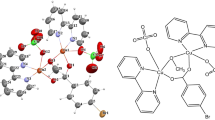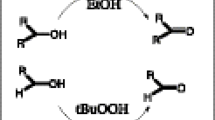Abstract
The 2+2 condensation of pyridine-2,6-dicarbo×aldehyde with BISDIEN produces a macrocyclic tetra Schiff base with a 24-membered ring in good yield. The macrocycle reacted with two equivalents of Cu(CH3CN)4PF6 to form a binuclear Cu(l) complex. The latter complex reacted with one equivalent of dioxygen to produce a complex which is believed to contain a µ-peroxo group bridging the metal centers. The half-life of this dioxygen complex was found to be about 100 minutes at 25 °C. The dioxygen complex was found to oxidize the substrates 2,6-dimethoxyphenol, 2,6-ditertiarybutylphenol, hydroquinone, tertiary-butylhydroquinone, 3,5-ditertiarybutylcatechol, 4-tertiarybutylcatechol, 4-methylcatechol, and 3,4-dimethyl-aniline. All of the redox reactions are catalytic, except for those of the last three substrates, with from three to five turnovers. The cycling of these catalytic reactions require that the binuclear Cu(ll) complex formed in the initial (two-electron) substrate oxidation also be an active oxidant of the same substrate. The binuclear Cu(ll) complex of the tetra Schiff base ligand was also synthesized and used as an oxidant for the substrates listed above. Only the substrates that were catalytically oxidized were also oxidized by the binuclear Cu(ll) macrocyclic complexes. The substrates that were not catalytically oxidized were not oxidized at measurable rates by the Cu(ll) complex. Comparison of the initial rate constants for oxidations by the binuclear Cu(l) dioxygen complex and for the binuclear Cu(ll) macrocyclic tetra Schiff base complex show that for the substrates examined, the Cu(l) dioxygen complex exhibits a significantly higher rate than does the Cu(ll) complex.
Access this chapter
Tax calculation will be finalised at checkout
Purchases are for personal use only
Similar content being viewed by others
Author information
Authors and Affiliations
Editor information
Editors and Affiliations
Rights and permissions
Copyright information
© 1993 Springer Science+Business Media New York
About this chapter
Cite this chapter
Rockcliffe, D.A., Martell, A.E. (1993). Stoichiometric and Catalytic Oxidation by a Binuclear Cu(I) Dioxygen Macrocyclic Complex Derived from Pyridine-2,6-Dicarboxaldehyde and Bisdien. In: Barton, D.H.R., Martell, A.E., Sawyer, D.T. (eds) The Activation of Dioxygen and Homogeneous Catalytic Oxidation. Springer, Boston, MA. https://doi.org/10.1007/978-1-4615-3000-8_67
Download citation
DOI: https://doi.org/10.1007/978-1-4615-3000-8_67
Publisher Name: Springer, Boston, MA
Print ISBN: 978-1-4613-6307-1
Online ISBN: 978-1-4615-3000-8
eBook Packages: Springer Book Archive




